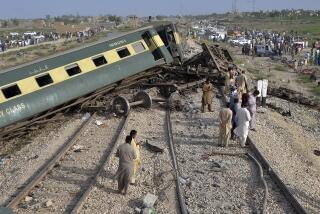Trains Collide in Britain; 5 Die, 80 Hurt : Cars Tumble Down Embankment in 2nd Crash in 3 Months
- Share via
LONDON — In the second major rail accident here in less than three months, five people died and about 80 others were injured Saturday afternoon when two trains collided on the southern outskirts of the city.
Officials said that only because the latest crash occurred on a weekend, when the trains were not full, the tragedy was not as deadly as the rush-hour collision that killed 35 commuters near London’s busiest rail junction last Dec. 12.
Doctors said that 20 of those hurt Saturday were in serious condition, mostly with multiple head, chest, and spinal injures, and that as many as 10 were listed as critical.
Saturday’s accident, which occurred within 10 miles of the December crash, apparently occurred when a slower-moving northbound train switched tracks in front of a faster train coming up behind it near the suburban Purley station.
The impact as the trains collided tore a gaping hole in one carriage and sent half a dozen others tumbling down a steep embankment. One came to rest in the back yards of a row of homes, stopping only a few feet short of the houses themselves. Residents were evacuated for fear that other derailed carriages on the side of the embankment could break loose and roll farther.
Rescuers Used Ropes
Local people helped pull the injured from crushed carriages, while firefighters had to use heavy cutting equipment to free more than a dozen others from the tangled wreckage. Rescue workers could only negotiate the steep embankment with the help of ropes.
There was much confusion during the evening over how many people had died. At one point, British Broadcasting Corp. television reported 12 fatalities. But Scotland Yard later said that five were confirmed dead.
“My daughter and I were deep in conversation when we heard this huge impact,” a survivor identified as John Lawrence told reporters at Mayday Hospital in East Surrey. “Following that, it was mainly a case of flying debris and bodies flying through the carriage as well.”
Lawrence’s head and jacket were caked with dried blood from cuts caused by flying glass.
The exact cause of the accident was not immediately clear, although Bernard Munn, a local resident, told Britain’s Press Assn. news service that he saw British Rail engineers working on signaling equipment near the site on Friday, apparently as part of routine monthly maintenance.
Faulty Signaling Work
British Rail has acknowledged that December’s crash near the Clapham Junction was caused by faulty signaling work there on the weekend prior to the accident. A public inquiry into the Clapham crash, which was this country’s worst rail disaster in 20 years, is still under way.
Prime Minister Margaret Thatcher was said by a spokesman to be “very distressed” by the latest accident and receiving minute-by-minute reports. Her junior Transport Minister, Michael Portillo, went immediately to the crash scene.
A Buckingham Palace spokesman described Queen Elizabeth II as “shocked” and also being kept informed.
The opposition Labor Party’s shadow transportation secretary, John Prescott, said there had been a 20% increase in rail accidents in recent years and a 30% increase in casualties. “I’m extremely alarmed that safety is not getting the priority it needs in our railway system,” he said, and he called for a full government statement to the House of Commons to explain Saturday’s accident.
Britain’s worst rail crash occurred during World War I on May 22, 1915, when a troop train collided with a passenger train, killing 227.
TRAIN TRAGEDY Five people were killed and 80 injured when a slow-moving northbound train apparently switched tracks in front of a faster train near the suburban Purley station in London.
Los Angeles Times
More to Read
Sign up for Essential California
The most important California stories and recommendations in your inbox every morning.
You may occasionally receive promotional content from the Los Angeles Times.













